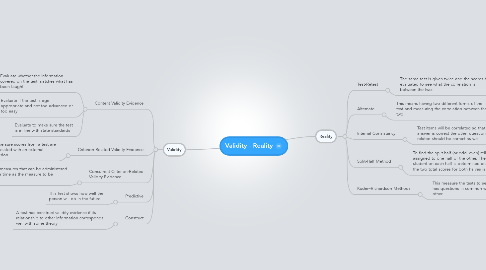
1. Reality
1.1. Test-Retest
1.1.1. The same test is given twice and the scores are evaluated to see what the correlation is between the two.
1.2. Alternate
1.2.1. This means having two different forms of the test and measuring the correlation between the two.
1.3. Internal Consistancy
1.3.1. Test items will be correlated so that when one answer is correct the other questions that are related should be correct as well.
1.4. Split-Half Method
1.4.1. To find the split-half (or odd–even) reliability, each item is assigned to one half or the other. Then, the total score for each student on each half is determined and the correlation between the two total scores for both halves is computed
1.5. Kuder–Richardson Methods
1.5.1. This measure the tests to see if it has questions in common with the other.
2. Validity
2.1. Content Validity Evidence
2.1.1. Evaluate whether the information covered on the test matches what has been taught
2.1.2. Evaluate if the test is age appropriate and not too advanced or too easy
2.1.3. Evaluate to make sure the test is in line with state standards
2.2. Criterion-Related Validity Evidence
2.2.1. Make sure scores from a test are correlated with an external criterion
2.3. Concurrent Criterion-Related Validity Evidence
2.3.1. Deals with measures that can be administered at the same time as the measure to be validated
2.4. Predictive
2.4.1. This test shows how well the person will do in the future.
2.5. Construct
2.5.1. A test has construct validity evidence if its relationship to other information corresponds well with some theory
